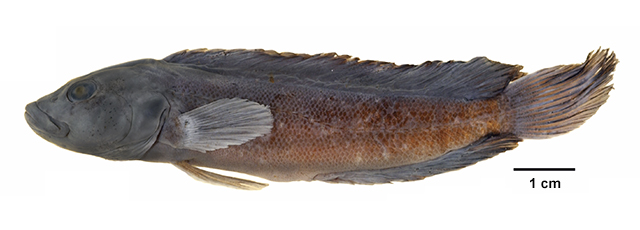|
Dorsal spines (total): 11-13; Dorsal soft rays (total): 8-9; Anal spines: 7-8; Anal soft rays: 8-9; Vertebrae: 30-32. This species is distinguished from its congeners by the following characters: absence of a sexual dichromatism of the caudal fin (vs. caudal fin of females with a distinctively marked dorsal blaze), markedly inflated pores in the laterosensory system of the head, jaws, suspensorium and infraorbital series; it has 5 separate infraorbital elements (vs. 4), and a robust lower pharyngeal jaw (versus a markedly more gracile element in congeners). Uniquely among congeners, T. obamaorum is a robust species lacking dorsoventral head and body depression; it is further readily distinguished from T. monogramma by number of anal spines (7-8 vs. 4), and from T. brichardi in the possession of 32-35 pored lateral-line scales (vs. 51-60) (Ref. 104438).
Description: Body deep and laterally compressed, with greatest depth at level of first dorsal fin spine; dorsal and ventral body profiles slightly convex to relatively short, deep, caudal peduncle; head robust rather than dorsoventrally compressed; adductor mandibulae muscle complex markedly enlarged lending bulging appearance to the cheeks. Snout prominent and bears single, tubular, nostril on either side; snout and dorsal head profile rise at angle of 35°-40° to midorbit, often with small, fat-filled, nuchal hump just anterior to dorsal fin origin in both sexes. Jaws prominent, slightly prognathous and robust with lips well developed and fleshy; inner and outer row teeth of both jaws pointed unicuspid; single series of 2-3 enlarged, recurved canines situated anteriorly on premaxilla; dentary with 3 enlarged canines anteriorly, larger pair slightly displaced dorsolaterally; remaining outer row of teeth in both jaws gradually taper in size and extend almost entire length of both jaws; 4 or 5 inner rows of small, slightly recurved, unicuspid teeth clustered on anterior third of dentary; no inner rows distally on lower jaw; two or three inner tooth rows anteriorly on premaxilla, tapering to single row; terminating at two-thirds of length of dentigerous arm. Lower pharyngeal jaw is markedly more robust than in congeners with slightly sinuous, rather than straight, ventral suture; usually 15-16 moderately robust, unicuspid teeth in posterior row; symphysial teeth enlarged and somewhat molariform. Gill rakers elongate, nondenticulate and slender. Dorsal-fin spines gradually increase in length posteriorly to around 8th spine then coequal in length; posteriormost branched fin rays of dorsal and anal fins reach to anterior third of caudal fin; caudal fin large and paddle shaped, with 14-branched rays (7+7) and rounded symmetrical distal margin; pectoral fins broadly fan shaped, long but falling short of anus, with 15-16 rays; pelvic fins falling just short of anus, with third branched ray longest in both sexes. All scales cycloid, with those on flanks small and somewhat irregularly sized; entire head and nape proximal to dorsal-fin origin naked; pectoral base and chest naked, scales over ventrum to anus very small and deeply embedded; scales immediately below dorsal-fin fold to level of 10-12th dorsal-fin spine markedly smaller than those on flanks; proximal third of caudal fin covered with small ovoid, scales; lateral line continuous and undivided; comprised of 32-35 elongate, pored scales, each approximately twice as large as unpored scales of upper and lower flanking rows; often 1 or 2 pored scales embedded distal to line of caudal flexion on caudal base (Ref. 104438).
Coloration: Males and females are similarly colored in life with base body coloration uniform smoky, grayish black becoming pale yellowish gray ventrally. In preservation, the base body coloration is dark brownish black, slightly darker dorsally becoming paler ventrally; unpaired fins are uniformly blackish brown (Ref. 104438). |
| Known only from a few rock outcrops located along a 40 km stretch of the middle Congo River, just upstream of Pool Malebo, in the Democratic Republic of Congo. In August 2011, when water levels in the main channel of the middle Congo River reached an historic low (July-September 2011), a series of rocky outcrops, which in previous (and subsequent) years had been completely submerged, became partially exposed and accessible for sampling; and it was only on these that specimens of Teleogramma obamaorum were collected. Since only very few rocky outcrops were located, and most of the shoreline was comprised of sandy or reed-fringed banks, this suggests that the short stretch where all T. obamaorum specimens were collected may represent the entire distributional range of the species. The stomach and full length of gut of all collected specimens contained small, intact shells of two species of rissooidean gastropods (superfamily Rissooidea) but in most cases, no other food items were present; a few individuals with some disarticulated remains of ephemeropteran nymphs. The male and female of this species are monomorphic and distinguished externally only by examination of the genital papilla. A female individual, although collected while reproductively active, also appeared to lack the pronounced red flush of color on the belly (reported to be observed with females of other Teleogramma species and most chromidotilapiines). Fecundity appears to be low, the largest female examined (6.38 cm SL) contained only 19 ovoid eggs measuring approximately 0.02 cm in height and 0.18 cm at widest girth and the smallest female (5.19 cm SL) contained 15 eggs of a similar size (Ref. 104438). |

